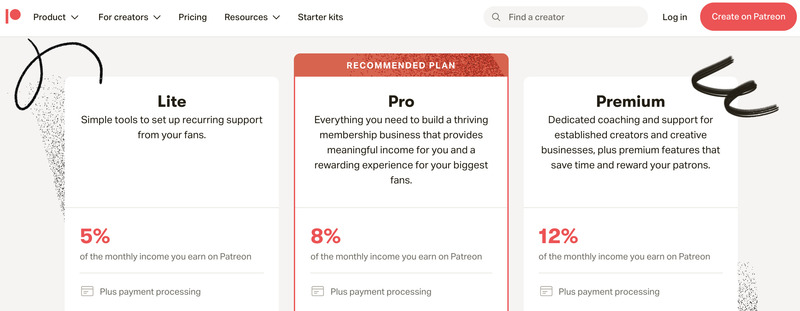Patreon is not free. Yes, you don't need to pay anything when you get started on Patreon; however, it is noteworthy that it charges 5-12% of the monthly income creators earn on Patreon (excluding payment processing fees).
In this article, we are going to deep dive into the problem with Patreon's pricing and everything you need to know if you really want to get started on Patreon.
What's the problem with Patreon's pricing?

Creators do not see the problem of such pricing model until it is too late. 5-12% of the monthly income might seem inexpensive when you just get started and have fewer than 100 patrons.
Here's the thing: it is very difficult to switch from Patreon to another platform as your creator business grows and the number of patrons increases - you have to pay 5-12% of the monthly income regardless of the amount of income.
Take a look at the table below.
| No. of patrons | Membership fee |
Patreon Platform Fee (8%) (assuming you choose the pro plan) |
Your income |
| 10 | USD20 | USD16 | USD184 |
| 100 | USD20 | USD160 | USD1,840 |
| 1,000 | USD20 | USD1600 | USD18,400 |
| 10,000 | USD20 | USD16,000 | USD184,000 |
- Note: the calculation excludes payment processing fees
The pricing plan offered by Patreon is a hidden trap.
At the beginning of a creator business, one would pick the cheapest option to get started. The price of such decision comes later. When the number of patrons grows from 10 to 1,000, not only does your income grow 10x, the platform fee you need to pay also increase 10x.
Does this make sense? Not really, as Patreon does nothing more than providing you a tool to collect your fan's membership fee - its effort and cost do not increase much as the number of your patrons grows.
When you want to switch from Patreon to a cheaper tool, it is already too late. A significant number of your fans subscribed to your membership on Patreons already. It would be very difficult, if not impossible, to ask all your patrons to switch to a new platform. That is why you should think twice before using Patreons as your membership platform.
In particular, here's four things you need to know.
1. Patreon does not help you promote your page; it is just a simple tool for you to collect membership subscription fee from your fans.
Let's be brutally honest. Patreon doesn't help you promote your page. You convert your audience on social media (e.g. Facebook, Instagram, Tiktok and YouTube) to loyal paid members because of (1) the high-quality content you create and (2) your personality that appeals to your audience; Patreon doesn't do that.
However, you are going to pay more platform fees as your creator business - the number of patrons - grows. Why do you need to pay on a commission basis to Patreon (like Grubhub and DoorDash) when it doesn't do anything that helps you acquire new patrons?
2. Patreon can take down your page anytime.

This issue is less mentioned in the public. Patreon's Trust and Safety Team has the power to take down your page anytime when they receive reports/complaints from anyone about your page content. Even if you complain and request for a review, you might not succeed.
Your years of efforts and monthly membership income can vanish all of a sudden - is it safe to build your creator business and whole career on Patreon where you have little control over your own page?
3. There is a cheaper and safer choice on the internet.
You need a membership subscription tool that doesn't charge you on a commission basis as your creator business grows. The growth in your business has nothing to do with the tool, unless it helps you acquire new patrons. There are a lot of great alternatives out there.
Taking Podia as an example, you just need to pay a flat fee of USD79 in order to create your own page and collect membership subscription from your audience. You get all the features you have on Patreon, at a much cheaper price.
4. Patreon doesn't allow you to set a free membership tier.

From a marketing perspective, a lot of creators offer a free membership tier with some utility to build engagement with audience who is not willing to pay for membership at the moment. With the email collected in this tier, creators can interact with this segment of audience and attempt to convert them to a paid member. This proves to be an effective tactic in building a creator's membership business.
Nonetheless, Patreon doesn't offer such features to its users - you cannot set a free membership tier for your audience.
Think twice before using Patreon for your creator business
It's very easy to get started on Patreon. It's also difficult to switch from Patreon to a cheaper platform as your creator business scales.The secret to getting ahead is starting right. Think for the long-term game.

